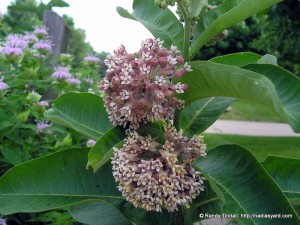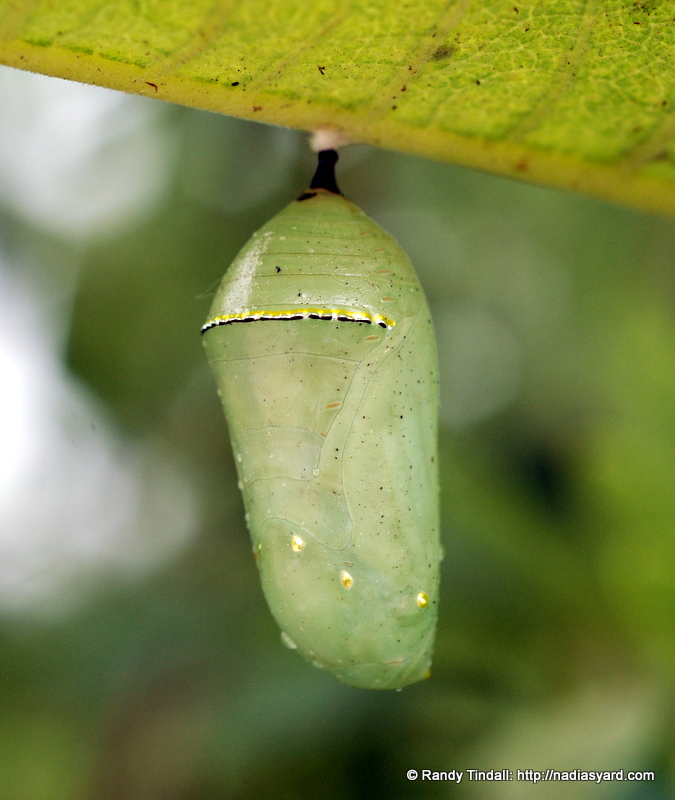My Dad stopped and stared at some plants in our yard, then turned to stare at me. “Did you just forget to pull these things?” he asked. “Because if you did, I can do it for you now.”
“No”, I said. “They’re supposed to be there.”
He shook his head in disgust. “You mean, I spend half my life pulling these out of the beans, and you’re planting them?”
Some things are hard to explain. He was glaring at a small patch of common milkweeds growing in our yard and thinking back to the almost forgotten ritual of bean-walking, one of the ways farm kids earned spending money in the hot Iowa summers of days gone by.
It wasn’t hard to see why the sight of an arch-enemy like milkweeds could raise the hackles of a retired farmer. Bean-walking involved miles and miles of shuffling up and down long rows of soybeans, hand-weeding the fields of anything that didn’t belong there. That meant everything except soybeans, and it especially meant milkweeds. Bean-walkers carried a hoe or machete (corn knife) and used them to chop out thistles, volunteer corn and other weeds from the crop. Some weeds, like cockle-burs, could be pulled up easily, dirt knocked off the roots, then left to wither in the sun on the black soil. Others, like milkweeds, pulled hard, and a really big one could defeat the efforts of a smaller bean-walker, although it was a point of honor to give it your all. A big patch of milkweeds took time to work through and left your hands (gloved, if you were smart) coated with sticky sap and your back aching. The bigger the patch, the longer it took to reach the end of the row where the cold water or kool-aid waited in big thermos jugs. Some of those rows took awful long.
This was more than just weed control to improve crop yields. This was agricultural aesthetics, and milkweeds had no place in them. Farmers could be very opinionated about the state of another farmer’s fields, since a messy looking field, in the mind of the onlooker, often pointed to a messy farming operation in general. It was just unprofessional, and my Dad farmed professionally. He could, and often did, spot a lone cockle-bur or milkweed in the middle of one of our fields as he was driving down the road. If he was lucky enough to have one of us kids in the car with him, well, it saved him some walking. Most of the time he had to direct us to the offender, shouting directions from the car, sometimes until we were standing right next to it. It was almost supernatural how he could spot weeds at a gallop. The result was fields that looked like newly cleaned carpets. They were beautiful in their own way, and even I took some satisfaction in knowing I helped to make them that way.
Walking beans was as much a part of summer as watermelons and sweet corn, but not as nice, if you want my opinion. Whole families, young and old, walked their own fields, starting early in the cool mornings and aiming to quit when the sun got to be too much, and I guess today that would be called “quality family time”, but I had other names for it. Boys and girls able to work hard enough to actually get paid would hire out to other farmers, sometimes teaming up with a friend or two or a bean-walking crew. Since this was before they told us that the sun was our enemy, we wore as little as possible, turning brown as nuts as the weeks passed, and this could have more immediate hazards than skin cancer. I still have the scar on my shin from the day when I was working a corn-knife and watching the older girl a couple rows over from me, instead of the plant I was chopping. She was walking beans in a bikini she had made herself. It was bright yellow.
I figured it probably wouldn’t do much good to tell my Dad that these milkweeds were natives and belonged here, or that a weed is just a good plant growing in a bad place. I may have told him about all the Monarchs we raised on them and sent south, but I doubt if he cared awful much about that. In his mind, these old enemies would soon pop open their pods and send thousands of seeds wafting though the air on little parachutes, heading out on the wind to infect some hard-working farmer’s beans. And that’s just not right. So I dodged and told him that these milkweeds were Nadia’s idea. After all, she grew up in a city and never had to pull them by the hundreds.
Bean-walking has mostly gone the way of corn detassling, square-baling hay, and shelling corn as rites of passage for farm kids. I’ll leave it to others to decide if this is good or bad. My take is that I’m awfully glad I did it then, and I’m awfully glad I’m not doing it now. Most of my callouses are gone now, and I mainly interact with milkweeds by admiring them and photographing the huge number of insects that come to pollinate them, feed on them, or raise their young on them. These are plants with place and purpose.
But I don’t think my Dad will ever see it that way.



Great story Randy. Timely for me because I was just thinking of planting some milkweed in our yard. Wonder what the neighbors would think of me then?!
Thanks, Kim! I’d say put in the milkweeds. The variety of insects that use these plants is just amazing, and there are quite a few milkweed varieties to choose from. We have several here and they really contribute to the presence of pollinators in our yard. Plus, they’re pretty. Except to my Dad. :-).
One thing we do that seems to keep the city happy is use plant labels to identify our natives. That way everybody can see that our “weeds” are there for a reason and that the yard is actively managed. I’m sure not all the neighbors totally approve, but they’re a good bunch of folks and we all coexist just fine. Good luck!
Oh, the memories. Love this story. You are right, dad never would have understood admiring milkweed.
He probably thought we were traitors!